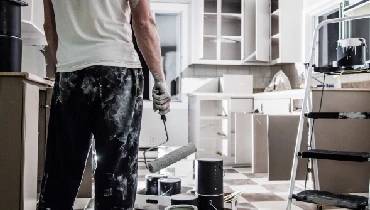How Hard Is It to Paint Cabinets?

Starting a DIY project like painting your cabinets may come with different expectations. For many people, a few drips or splotches of paint here and there isn’t a big deal when you feel like you’re saving money, right? These folks are happy to set aside a weekend or two (or four) to paint their cabinets.
For others, such blemishes are unacceptable. If the finished product isn’t perfect, it’s not worth doing. So, these people may spend a lot of extra time and effort to make this painting project perfect. But what if you spend all that extra time on perfection that doesn’t happen? You may discover that painting cabinets like a pro takes experience, and the right equipment.
Before you dive brush first into this DIY project there are some things you should know about painting cabinets. Here are some tips and things to avoid if you decide to take on this task yourself.
Is It Hard to Paint Cabinets?
It can be, but just like with many other DIY projects, success depends on your expectations, level of experience, and the tools and equipment you have available. Here are five things that may surprise you about painting cabinets:
Equipment Cost: By far the best way to paint cabinets is with a paint sprayer—no exceptions. Sure, you can brush and/or roll paint on your cabinets, with good results. However, for a paint finish that looks professional and is durable, a paint sprayer is the way to go. Painting your cabinets with a sprayer allows you to apply a steady, even coat of paint. However, using a sprayer properly does take some skill and experience. In addition, a quality paint sprayer can cost a few hundred dollars, which will cut into any cost savings you were trying to achieve by doing this job yourself.
The Space Required: If you decide that spraying your cabinets is the best option, you’ll need a dedicated area to spray them. Although this could be your kitchen, you’ll need to hang plastic everywhere to minimize the risk of overspray paint ruining appliances or other areas of your home.
Proper Ventilation: Before taking on any indoor painting project, you should ensure you have adequate ventilation. If opening windows and doors is an issue, your garage may be an option, if it’s warm enough (at least 50 degrees). You’ll still need to hang plastic sheeting to contain the overspray, but at least your whole house won’t be filled with paint fumes. Even if you decide to paint using a brush and/or roller, you’ll still want a dedicated space to paint the cabinets and let them dry.
Please don’t try to paint your cabinets in place. You’ll be dealing with the dust (you sanded them, right?), and residue for days and weeks. And your kitchen will be shut down during that time too.
Prep Required: As mentioned, the room where you decide to paint your cabinets won’t be very functional during this project. So, plan on not using it or if necessary, you’ll have to figure out how to work around the mess until the project is completed (which can vary based on your experience and size of the project).
You may be tempted to paint the cabinet faces without removing them. Although it can be done, and seems like an easier alternative, it is not recommended. In order to prepare your cabinets for painting, all the doors should be removed (remember that sanding part?). We realize you can’t move the cabinet bases or frames, and those will stay in place.
Other Factors to Consider: Should you paint behind the cabinets? What about the insides? Should the shelves match? Can you use the same paint for your hardwood doors as you can for the MDF shelves and bases (maybe).
Are you swapping hinges and hardware? Do the old holes line up? If not, how will you fill in the old holes and drill the new holes? Do you have to sand the cabinets?
When you consider all of these other factors it is safe to say that cabinet painting can be a little more involved than most people think. To get it right, it’s important to follow the right sequence and use the correct techniques, material, and equipment.
Related Topic: Replacing Cabinet Knobs and Hinges
The Skill Required
Although painting is not hard, it does require some skill and a lot of patience. Cutting in around the cabinet bases (where the wall of floors meets the cabinet) can be tricky and a time-consuming process. Using painter’s tape to mask off certain areas also takes time and doesn’t always guarantee a perfectly straight line since paint can bleed under the tape. And if you decide a paint sprayer is your best option. Well, using one correctly takes some skill, experience, time and finesse.
This brings us back to the question, how important is a perfect paint job to you? If you have the time, patience, skill, and the right equipment, then painting cabinets yourself can be a great way to save some money. Just be prepared to invest some long nights and weekends in this project.
Related Topic: Home Painting Tips
Don’t Have the Time, Skill or Patience?
If after reading this article you have come to the decision that you’re not ready to invest the time, energy and effort needed to paint your cabinets like a pro, don’t worry. There are local professionals who offer cabinet painting services to help you get your cabinet project completed. If you need help completing other projects around your home, the local pros at Mr. Handyman can help you with that too! To learn more about the services we offer, give us a call or schedule an appointment online today.
 Click to call
Click to call


